The tomb of Nebamon and Ipouky is unique in more ways than one. While the chapels studied by the team with chemical analysis instruments and photographic documentation are generally dedicated to a deceased person and his relatives, here it is two men who share the space, while not apparently having no known family relationship since the parents of the two deceased are cited separately. 9th episode of the Notebooks of Egypt.
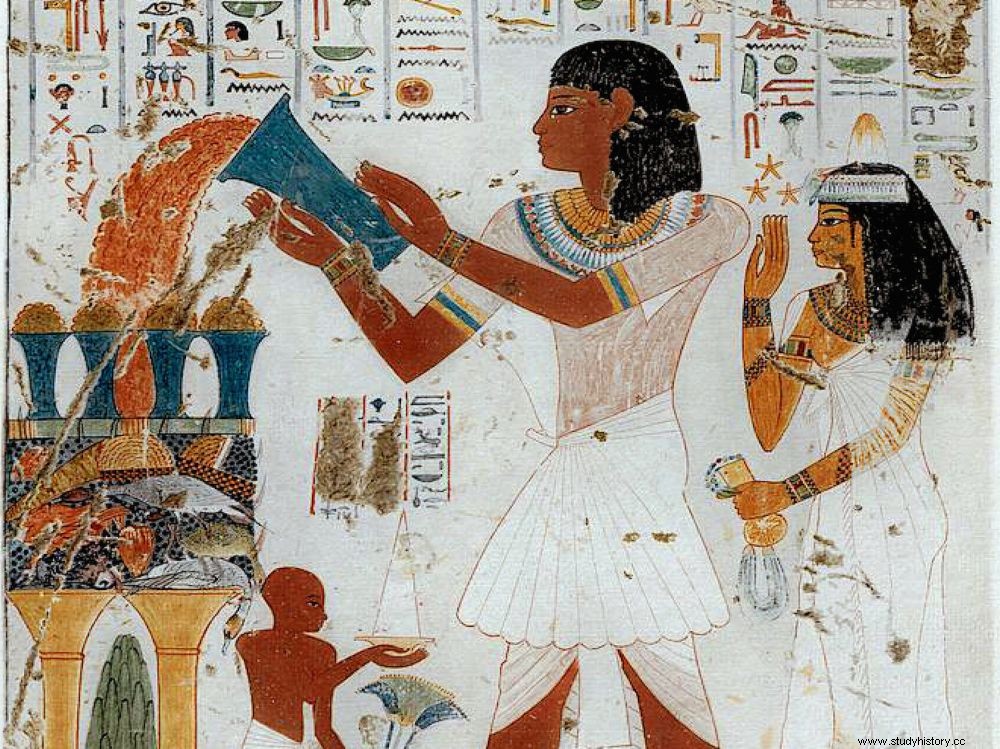
Nebamon and his mother Thepu make a large offering to the goddess Hathor. Watercolor by Norman de Garis Davies.
Ipouky is son of Sennetjer, "Head of the craftsmen of Héryhirmerou" . He was himself "controller of the King's weighing in Set-Djéséret (Médinet Habou) ", but also "king's sculptor " and "Chief of the King's Sculptors ". Nébamon for his part is also superintendent of sculptors, but also "controller of the secret department of Héryhirmérou ". He is also "child of the Kap", which implies that he was brought up near the prince who became king, which undoubtedly gave him privileged access to the latter. He also holds his main title of "superintendent of sculptors "of his father Neferhat who already bore the same title. These two characters are therefore artists themselves, but, at this stage of their career, they are in charge of controlling several workshops and probably especially those of precious materials implemented.
"This is the tomb of two sculptors who were in charge of controlling several workshops"
While from a purely aesthetic point of view, the tomb seems, at first glance, divided in two by style alone, the two owners take part in a relatively equal way in the different moments of the decorative program, although none of the scenes never be duplicated. The distribution of roles is done according to a delicate balance. It is Ipouki who enters the tomb wearing a superb pectoral, and it is doubtless he who comes out accompanied by the lady Henutneferet, while Nebamon prefers the company of his mother Thepou.
It is possible that Nebamon was Ipuky's successor. And it is perhaps he who sets up the decoration of the tomb which gives it a clear pre-eminence. For the two men, Hénoutnofret is "senet", a term which, at that time, designates both the sister and the wife. She thus finds herself perhaps at the center of the decorative system of the small chapel, as the sister of Nebamon and wife of Ipouky.
This is probably why the two offerings made on either side of the door honor the goddess Hathor, the Golden, rather than the sun god usually found in this place. On the right, Nebamon also makes an offering to Osiris and his descendants, the sons of Horus. This fact is remarkable, because, at that time, the deceased rarely had direct access to the deities. On the same wall, Nebamon and Ipouki are represented busy performing the funerary cult in front of their respective parents.
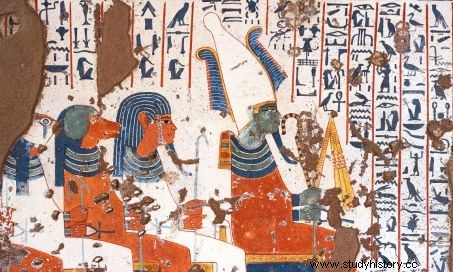
Osiris and the Sons of Horus. ©LAMS/MAFTO/CNRS
"A remarkable scene shows the work of goldsmiths and carpenters"
Scenes of "everyday life" are quite rare here. But the one that shows Nebamon playing his role as controller of the arts is remarkable. In front of him is the attendant with the scales, on which are placed gold bracelets, equivalent to our ingots of raw material. Then come a whole small troop of goldsmiths and carpenters, assembling precious furniture, giving shape to complex pieces of goldsmithery.
Some characters are humorously characterized as rather scruffy, chubby or bald, sporting a beard of several days. One of them saws ebony slabs by having wedged a log between two pieces of wood forming a vice. In the lower register, a founder stokes the fire of a crucible using a blowtorch. A moving little scene caught our attention as "colorists":a craftsman makes a precious chest decorated with pharaoh's cartouches. His sidekick seems to be delicately polishing a blue material, an ornamental stone that his gesture by itself makes precious.
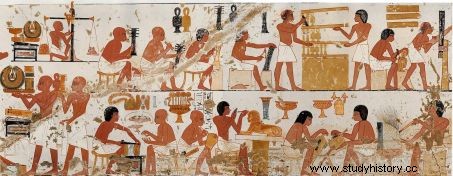
The goldsmith's workshop overseen by Nebamon. Watercolor by Norman de Garis Davies ©LAMS/MAFTO/CNRS
"The funeral ceremonies concern the two deceased"
Further on, other scenes bring us back to a less happy reality and the funeral ceremonies concerning the two deceased. The sarcophagus containing the mummified body is placed on a sled drawn by four oxen with various colored coats. In front of them runs a gray calf which, in its joyous haste, comes to overflow the traditional framework of the scene. A similar scene evokes the transport of the four canopic jars which contain the organs of the deceased:by nature putrescible, the latter threaten the bodily integrity of the deceased. They were therefore removed from the body. But being part of his essential person, there can be no question of getting rid of it. Immersed in a bath of natron and protected by their appointed gods, they accompany the deceased to their eternal home.
The lower register shows the crossing of the Nile by the funeral procession. A first skiff received at the quay carries the colleagues of the deceased. Next come the grave goods, followed by a good-sized, colorfully decorated barge. On the roof of the cabin stand the mourners in a disheveled and gesticulating crowd, while the men seem totally prostrate under the weight of pain. This ship tows the boat supporting the funerary chapel covering the sarcophagus and mummy of Osiris Nebamon/Ipouky, ritually mourned by two women playing the role of the goddesses Isis and Nephthys.
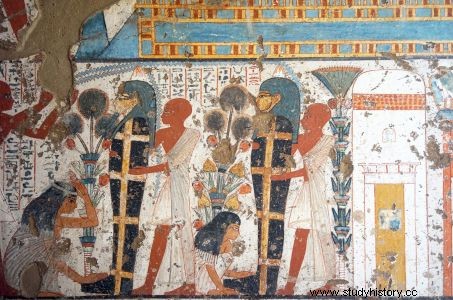
The mummies of Nebamon and Ipouky in front of their tomb. ©LAMS/MAFTO/CNRS
The friends of Nebamon and Ipouky have come together to transport to his tomb, in a ritual land convoy, the objects that will accompany him to his sepulchral chamber:we see chests, a seat, a bed and the bedside table that completes it. , but also the tools of his corporation. He heads for the necropolis and the entrance to the tomb. In front of it are aedicules where priests prepare offerings and funeral meals. The mourners follow the celebrants responsible for carrying out the "opening of the mouth" ritual which aims to restore to the deceased the use of his senses with a view to his post-mortem regeneration. Two sarcophagi are erected in front of the tomb, supported by the son and heir and mourned in a touching way by the widow. They probably represent respectively Nebamon and Ipuky who, although probably dead at different times, share the same funeral ritual for eternity.
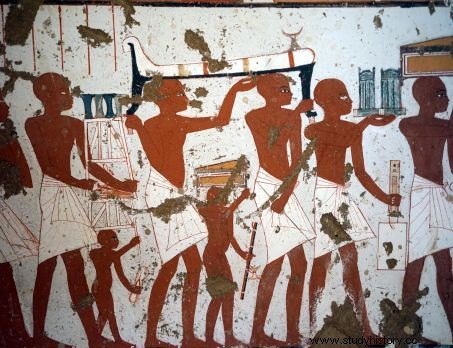
Transportation of funeral furniture. ©LAMS/MAFTO/CNRS
"The chapel of the artists Nébamon and Ipouky is a fragile masterpiece"
Located at the bottom of a cavity, it suffered from the regular invasion of rainwater which ruined the lower parts of its walls, whereas these had been decorated with the greatest care, a relatively rare occurrence in the necropolis. theban. It had already suffered the attacks of the zealots of Aten a few years after its creation, the hammering affecting the name of the god Amon or his companion Mut, but also the plural of the word "gods" or the image of the sem-priest dressed in his panther skin. Its unstable ceilings had crumbled and some scenes were already damaged beyond repair when Norman and Nina Davies made a superb watercolor copy of it for the Metropolitan Museum in New York.
This publication saved irreplaceable information with unfortunately rare talent, while perhaps attracting too much attention from unscrupulous collectors. The tomb was savagely attacked and whole sections of its decoration torn from its walls, destroying a good number of collateral surfaces. These fragments surfaced in various Western collections:Louvre, Brooklyn, Kansas City, Princeton, Boston, Hanover... Others may still be found in private collections that are difficult to access.
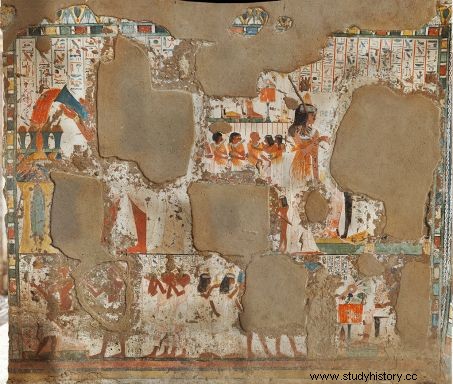
One of the walls of the tomb in its current state ©LAMS/MAFTO/CNRS
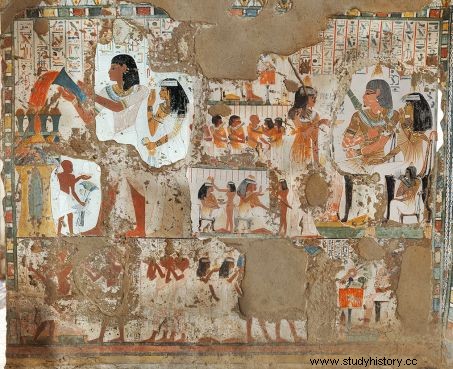
The same wall, with reconstructions of scenes still preserved in situ around 1925. ©LAMS/MAFTO/CNRS
"If they have not been restored too wildly, these fragments, both sad and magnificent, can provide us with additional information about this chapel and the artists who planned it and created its decorations. It would be a fitting tribute on our part to the work of these painters who, through its distressing ruin, nevertheless manages to generate unique emotions in us, 3500 years after its creation" , comments Philippe Martinez, Egyptologist at the Molecular and Structural Archeology Laboratory (Sorbonne University – CNRS).
Notebooks of Egypt, 1st episode:how did the painters of ancient Egypt work?
Notebooks from Egypt, 2nd episode:Discovering the funeral chapel of Nakhtamon.
Notebooks from Egypt, 3rd episode:The pigments of Egyptian painting.
Notebooks from Egypt, 4th episode:The modern documentation of painted walls.
Notebooks from Egypt, 5th episode:Rediscovering the monuments of eternity of Ramses II.
Notebooks from Egypt, 6th episode:Revealing pigments with light:the visible and the invisible.
Notebooks from Egypt, 7th episode:Experiencing research through images.
Notebooks of Egypt, 8th episode:Beginning of the study of the paintings of the tomb of Nebamon and Ipouky.
Notebooks from Egypt, 9th episode:A tomb shared by two artists under Amenhotep III.
Notebooks from Egypt, 10th episode:What the tomb of Amenouahsou, an artist from ancient Egypt, reveals.
Notebooks from Egypt, 11th episode:Strange uses that have been made of Egyptian mummies.
Notebooks from Egypt, 12th episode:"Why don't all the artists come here?"
Notebooks of Egypt, 13th episode:Why did the Egyptians draw the characters in profile?
Notebooks from Egypt, 14th episode:Observing craft practices in Egyptian tombs.
Notebooks from Egypt, 15th episode:About Egyptian perfumes.
Notebooks from Egypt, 16th episode:The colors of the Egyptian palette.
Notebooks of Egypt, 17th episode:The Egyptian language does not know a word to designate "art".
Notebooks of Egypt, 18th episode:The day of a scientific mission in Egypt.
